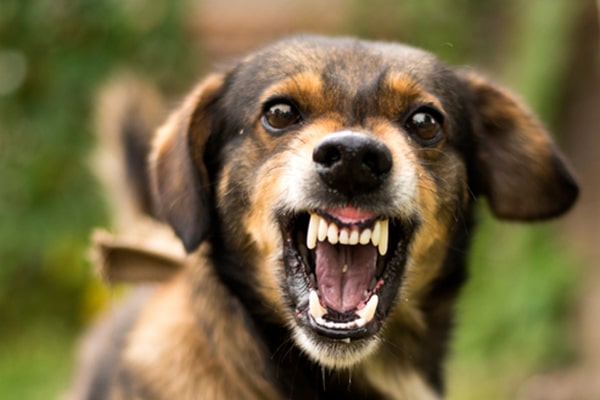The little dog had been in our training center for 15
minutes before he noticed the giant painting of a dog hanging on the
wall. His eyes widened as he took a step toward it, growling. “Pssht!”
his owner hissed, snapping her fingers at him. He jerked in surprise,
then sat down and licked his lips. The dog growling didn’t happen again,
but he continued to stare at the painting, trembling slightly, paw raised.
First, why does dog growling happen?

Why does dog growling happen? Photography ©Volodymyr_Plysiuk | Thinkstock.
Dog growling happens for a variety of reasons. Fear,
insecurity, guarding behavior, offensive aggression and play can all
elicit dog growling, although to an expert these growls are each unique
in their tone and pitch. Outside of play, dog growling serves as a
warning that all is not well in the dog’s world. Something is off, and
our dog is doing us the courtesy of sharing that information.
Responding to dog growling
“Why did you just snap at your dog?” I asked the little dog’s owner.
“I want him to know that I won’t tolerate that behavior,” she replied.
It’s human nature to respond negatively to a dog’s growl.
Dog growling is an undesirable behavior and can oftentimes be a
precursor to a bite. However, as I explained to the little dog’s owner,
it’s important to suppress your urge to correct your dog for growling.
Thank your dog for growling, and remove or redirect him from the
situation that’s provoking the dog growling. It’s better than the
alternative.
Here are four things you need to know about dog growling:
1. Dog growling serves as a warning signal
Dog growling tells you that your dog is unhappy or uncomfortable. Something is wrong. Think of it as an early warning system.
2. Punishing a dog for growling takes away your early warning system
Dogs who are punished for growling oftentimes learn not to
growl. However, getting rid of the growl doesn’t fix the underlying
cause for dog growling, which leaves us with a dog who is just as upset
as before, but now has no way to express that discomfort except for
escalating his display. The growl may be gone, but now you’ve created a dog who will bite “without warning.”
3. All dogs warn
If your dog doesn’t warn before he bites, it’s either
because you’re missing his precursor signals or because he no longer
feels safe displaying them. Either way, the fault here lies at the other
end of the leash.
Dogs who go straight to biting without displaying lots and
lots of precursors are much more difficult to treat. I would much
rather work with a dog who stiffens up, displays whale eyes,
hard-stares me, curls his lip, growls, freezes and then (finally)
bites, than a dog who goes straight from a freeze to a bite. It will be
much easier to keep the situation safe with the first dog. The latter
case is much riskier.
4. If your dog growls, he believes he has a valid reason to do so
The little dog was understandably worried by what he
perceived was a giant dog, frozen and staring at him (both
confrontational and potentially aggressive behaviors) from across the
room.
His owner would have done better to acknowledge his fear,
using treats to reward him for looking at, and later on investigating,
the frightening painting (and she will in the future, as she now has the
tools to better deal with situations that make her dog uncomfortable).
In this situation, the dog growling was merely a symptom of his
insecurity. Treating the underlying cause will make the symptom
disappear far more effectively than suppressing it.
Tell us: What situations cause your dog to growl? How have you addressed dog growling? Please share your stories in the comments!Thumbnail: Photography by Robynrg / Shutterstock.
